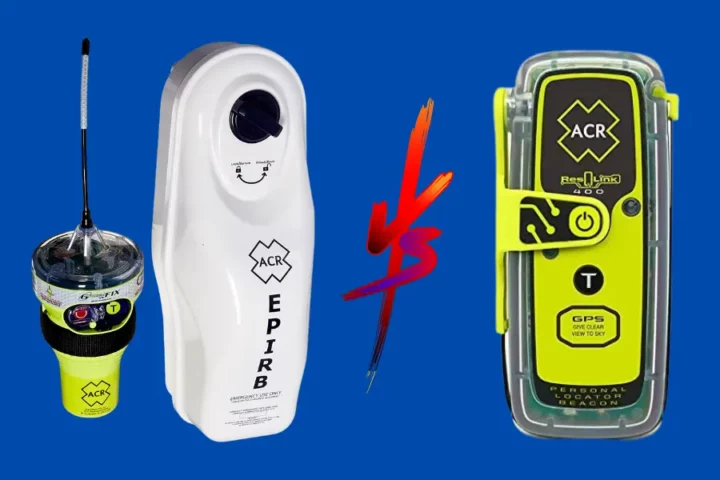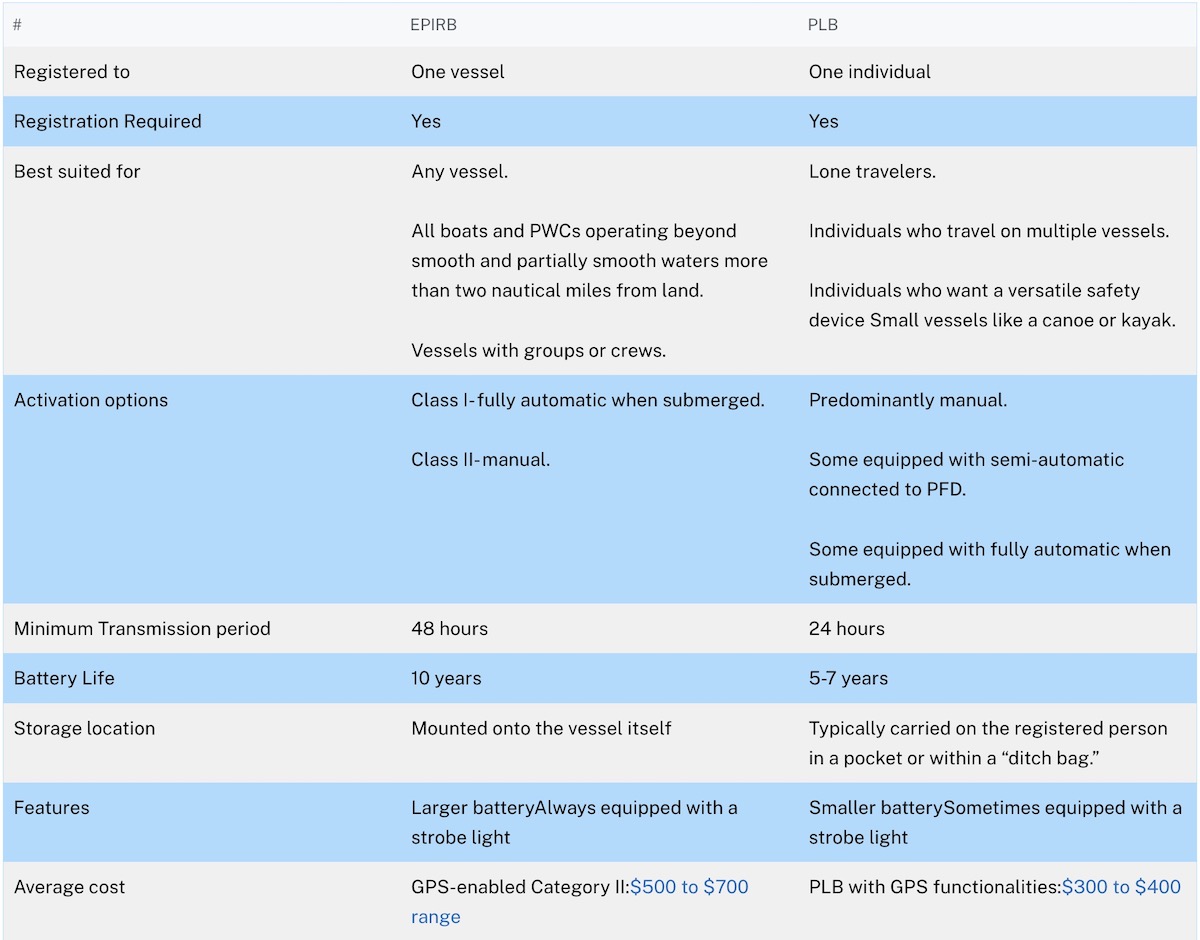If you plan a long trip into remote areas, you will need an EPIRB and/or a PLB. While these two devices are frequently confused with one another, some distinct differences set them apart and warrant the use of one over the other in certain situations.
Although the ultimate goal is never to have to use these devices, they are undoubtedly crucial to pack for the safety of you, your vessel, and any co-travelers.
It is important to know the differences between an EPIRB and a PLB in terms of design, when to use them and what situation each is best suited to.
Topics Covered - Index

Therefore, we’ve provided a detailed guide that describes each device to help you better determine which is right for you and your expeditions.
EPIRB vs. PLB
The major difference between EPIRB and PLB is that EPIRBs are registered to an individual vessel while PLBs are registered to an individual. Also, Class I EPIRBs are fully automatic when submerged while most PLBs are manual or semi automatic. EPIRBs and PLBs are both essential safety devices you should have with you on offshore ventures. However, it can be hard to determine which is the best choice for you.
The chart below clearly shows the similarities and differences between EPIRBs and PLBs to help you determine when to buy a PLB over an EPIRB or vice versa. You might even decide that the best choice is to have at least one of each on hand when you leave land behind.
| # | EPIRB | PLB |
|---|---|---|
| Registered to | One vessel | One individual |
| Registration Required | Yes | Yes |
| Best suited for | Any vessel. All boats and PWCs operating beyond smooth and partially smooth waters more than two nautical miles from land. Vessels with groups or crews. | Lone travelers. Individuals who travel on multiple vessels. Individuals who want a versatile safety device Small vessels like a canoe or kayak. |
| Activation options | Class I- fully automatic when submerged. Class II- manual. | Predominantly manual. Some equipped with semi-automatic connected to PFD. Some equipped with fully automatic when submerged. |
| Minimum Transmission period | 48 hours | 24 hours |
| Battery Life | 10 years | 5-7 years |
| Storage location | Mounted onto the vessel itself | Typically carried on the registered person in a pocket or within a “ditch bag.” |
| Features | Larger batteryAlways equipped with a strobe light | Smaller batterySometimes equipped with a strobe light |
| Average cost | GPS-enabled Category II:$500 to $700 range | PLB with GPS functionalities:$300 to $400 |

When to Activate an EPIRB or PLB?
EPIRBs are safety devices you should refrain from using until absolutely necessary. This is because the device will emit a signal meant to contact authorities, who will dispatch a search and rescue team for your assistance.
Not only is it costly for these resources to find you, but the search and rescue team members often put themselves in danger to come to your aid. Therefore they must reserve the time, money, and effort they spend on this endeavor for individuals in utter peril.
If you aren’t actually in an emergency situation, you are potentially taking those search and rescue team members away from a distress call where they’re truly needed.
In addition to what it costs your national and local authorities, using your EPIRB or PLB device for distress signal emissions will effectively drain its battery, which will warrant a replacement. While these devices don’t typically sport a $1,000+ price tag, they certainly aren’t cheap, so you’ll want to reserve their one-time use for when it is truly essential.
The only time it’s worth activating your EPIRB is if there has been a major emergency, like:
- Capsizing or sinking
- Fire onboard
- Collision with another object
- Serious medical injuries
- Man overboard location unknown
- Stranded vessel of crewmates
EPIRB and PLBs are ultimately safety devices, so if you feel you are in a situation that truly warrants their use, don’t hesitate to activate them. But, before you do so, it is always recommended you take a moment to reflect and determine if you are truly in an emergency situation that warrants using this device is your last resort.
Is It Required for Me to Have an EPIRB or PLB?
While EPIRBs and PLBs are great backup devices to have in the case of an emergency, some wonder whether they are truly necessary.
In terms of an EPIRB, it is actually mandatory for boats traveling further than two nautical miles offshore to have one of these devices equipped and registered on board. This is to ensure the safety of the vessel and everyone on it.
In terms of a PLB, it is rarely mandatory for a traveler to purchase or carry one of these devices. It is certainly recommended, particularly when traveling alone offshore or in dangerous terrain, but there are really only two requirements for PLBs, both of which they share with EPIRBs.
Firstly, all PLBs must be registered to someone at all times, and secondly, the information connected to your PLB registration must be up to date with the most current information you can provide.
What is an EPIRB?
An Emergency Position Indicating Radio Beacon (EPIRB) is a radio transmitter that will broadcast the position of any vessel experiencing distress. The device can be activated automatically once submerged in water or manually. A Personal Locator Beacon (PLB) functions similarly to an EPIRB but is smaller and registered to one individual.
As opposed to a PLB, which we’ll discuss in further detail later, and EPIRB is registered and connected to a particular vessel, not an individual user. Therefore, when it releases a distress signal, authorities will be searching for the associated vessel rather than one or multiple people.
The EPIRB ensures the vessel can be found by transmitting a coded message with the vessel’s identity on the 406 MHz distress signal.
This signal sent to this satellite is extremely accurate at 2 to 5 km vice 25 km, which is one of the reasons the 406 MHz EPIRB is the model currently permitted for international use rather than the previous 121.5 MHz and 243 MHz devices that were far less accurate.
- Build a 40’ Antenna Mast at Home
- Build a TV Antenna Amplifier
- Improve FM Signal on Radio
- Listen to the Super Bowl on the Radio
- Speed of Radio Waves
- Best AM FM Portable Radios
What is a PLB?
A Personal Locator Beacon (PLB) is very similar to an EPIRB with a few distinct differences. As indicated by its name, a PLB is meant specifically for an individual in distress and is therefore registered to one person rather than a vessel. This is the most important distinction between the two safety devices.
Similar to the EPIRB, it is also required that all PLBs be registered to their owner, and the information connected to this advice is up to date.
These devices are helpful for individuals that tend to sail on multiple vessels over time, but it is important to note that these vessels must also be registered on your PLB, so authorities can more easily find you in moments of distress.
A nice benefit of PLBs is that they are far more versatile than EPIRBs because they are not limited to a particular vessel. This means that PLB devices could be used for virtually any emergency scenario, such as a lost hiker, a helicopter crash victim, a skier caught in a landslide, and many other examples where rescue is essential.
Because PLBs are designed for one person rather than an entire vessel, they are much smaller in size, effectively altering other design and functionality elements. For instance, PLBs will only emit your distress signal for up to 24 hours because of their shorter battery life, versus the EPIRB which can emit a signal for up to 48 hours.
Another functionality difference is that most PLBs must be manually activated as opposed to the EPIRB with its Class I and II activations. For this reason, it is especially important to keep your PLB on hand at all times.
However, improvements on PLB designs, particularly for offshore devices, have resulted in some PLBs having a semi-automatic activation that relies on the individuals’ Personal Flotation Device (PFD) while others have automatic water activations like the Class I on EPIRBs.
In terms of satellite communications, a PLB works exactly the same as an EPIRB. Both will broadcast a distress signal to the COSPAS-SARSAT System satellites, and then that information will be transferred to the appropriate resources until local authorities release a search and rescue party.
Final Thoughts on EPIRBs vs PLBs
Despite the fact that EPIRBs are mandatory on offshore vessels, they are undoubtedly essential devices to have on hand and can be the difference between life and death in an emergency situation. If you’re an avid traveler that rarely sticks to one vessel for your adventures, we recommend investing in a PLB.
These smaller devices are registered to a specific individual rather than an entire vessel, as is the case with an EPIRB, and can help ensure your safe return in unexpected moments of peril. Whether you think you’ll need them or not, it is always wise to have one, if not both an EPIRB and PLB around. Their cost is worth the extra safety and peace of mind in the open water.
Additional Sources:
- https://www.youtube.com/watch?v=IMm9RpGiK_A&t=130s
- https://www.adecmarine.co.uk/epirb-alert-how-do-they-work
- https://www.rei.com/learn/expert-advice/personal-locator-beacons.html
- https://www.landfallnavigation.com/blog/2017/10/02/epirbs-plbs-and-ais-behind-the-acronyms/?gclid=Cj0KCQjw5PGFBhC2ARIsAIFIMNcuV00dAc9_GRYntVou7jwm8VpDC23aJTJPcDNgOEJURMky6duo75oaAmvcEALw_wcB
- https://www.navcen.uscg.gov/?pageName=mtEpirb